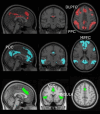Mindfulness-based neurofeedback: A systematic review of EEG and fMRI studies
- PMID: 40800428
- PMCID: PMC12315751
- DOI: 10.1162/imag_a_00396
Mindfulness-based neurofeedback: A systematic review of EEG and fMRI studies
Abstract
Neurofeedback concurrent with mindfulness meditation may reveal meditation effects on the brain and facilitate improved mental health outcomes. Here, we systematically reviewed electroencephalography (EEG) and functional magnetic resonance imaging (fMRI) studies of mindfulness meditation with neurofeedback (mbNF) and followed PRISMA guidelines. We identified 9 fMRI reports, consisting of 177 unique participants, and 9 EEG reports, consisting of 242 participants. Studies of fMRI focused primarily on downregulating the default-mode network (DMN). Although studies found decreases in DMN activations during neurofeedback, there is a lack of evidence for transfer effects, and the majority of studies did not employ adequate controls, for example, sham neurofeedback. Accordingly, DMN decreases may have been confounded by general task-related deactivation. EEG studies typically examined alpha, gamma, and theta frequency bands, with the most robust evidence supporting the modulation of theta band activity. Both EEG and fMRI mbNF have been implemented with high fidelity in clinical populations. However, the mental health benefits of mbNF have not been established. In general, mbNF studies would benefit from sham-controlled RCTs, as well as clear reporting (e.g., CRED-NF).
Keywords: DMN; EEG; fMRI; mindfulness; neurofeedback; theta.
© 2024 The Authors. Published under a Creative Commons Attribution 4.0 International (CC BY 4.0) license.
Conflict of interest statement
No competing interests are present.
Figures





Update of
-
Mindfulness-based Neurofeedback: A Systematic Review of EEG and fMRI studies.bioRxiv [Preprint]. 2024 Sep 15:2024.09.12.612669. doi: 10.1101/2024.09.12.612669. bioRxiv. 2024. Update in: Imaging Neurosci (Camb). 2024 Dec 20;2:imag-2-00396. doi: 10.1162/imag_a_00396. PMID: 39314394 Free PMC article. Updated. Preprint.
References
-
- Alleva , J. , Roelofs , J. , Voncken , M. , Meevissen , Y. , & Alberts , H. ( 2014. ). On the relation between mindfulness and depressive symptoms: rumination as a possible mediator . Mindfulness , 5 ( 1 ), 72 – 79 . 10.1007/s12671-012-0153-y - DOI
-
- Bauer , C. C. C. , Okano , K. , Ghosh , S. S. , Lee , Y. J. , Melero , H. , Angeles , C. L. , Nestor , P. G. , Del Re , E. C. , Northoff , G. , Niznikiewicz , M. A. , & Whitfield-Gabrieli , S. ( 2020. ). Real-time fMRI neurofeedback reduces auditory hallucinations and modulates resting state connectivity of involved brain regions: Part 2: Default mode network-preliminary evidence . Psychiatry Research , 284 , 112770 . 10.1016/j.psychres.2020.112770 - DOI - PMC - PubMed
LinkOut - more resources
Full Text Sources
